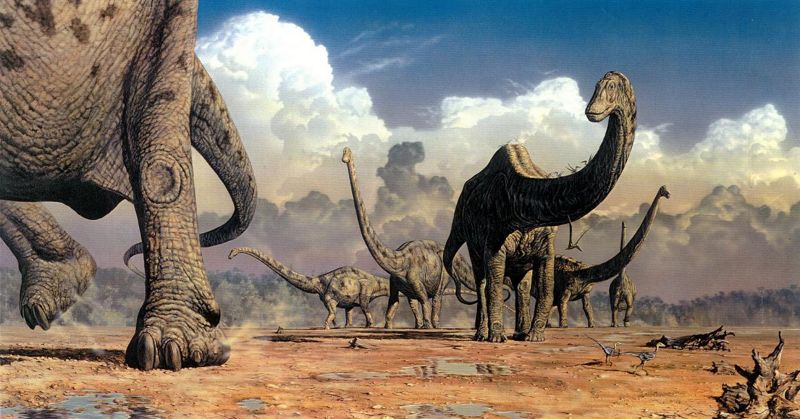
|
This image was uploaded to the shared "Image Pool" and is usable on any CreationWiki site.
Please go to the Pool to edit its description.
|
Featured Image
This image has been recognized for exceptional quality and value.
To browse other featured images click here.
|
Summary
"The Long March"
This painting, entitled "The Long March," depicts a herd of sauropod dinosaurs, Seismosaurus (Diplodocus) hallorum, migrating to new feeding areas during the seasonally dry environment of western North America's late Jurassic Period. Known from a huge, forty-percent-complete skeleton, Seismosaurus was discovered in the Brushy Basin Member of New Mexico's Morrison Formation by Dr. David Gillette and Wilson Bechtel. Associated with the skeleton were Gastroliths, or "stomach stones," that may have aided digestion. (Date of Image: 1994)
Copyright status
Images credited to the National Science Foundation, a federal agency, are in the public domain. The images were created by employees of the United States Government as part of their official duties or prepared by contractors as "works for hire" for NSF. You may freely use NSF-credited images and, at your discretion, credit NSF with a "Courtesy: National Science Foundation" notation.
Special Restrictions:
Credit line must be printed adjacent to all image reproductions/usages, as stated by the owner.
Credit: "The Long March" © 1994 Mark Hallett
Source
http://www.nsf.gov/news/mmg/mmg_disp.cfm?med_id=59777
File history
Click on a date/time to view the file as it appeared at that time.
| Date/Time | Thumbnail | Dimensions | User | Comment |
|---|
| current | 21:02, 24 November 2007 |  | 1,156 × 606 (189 KB) | Ashcraft | "The Long March" This painting, entitled "The Long March," depicts a herd of sauropod dinosaurs, Seismosaurus (Diplodocus) Hallorum, migrating to new feeding areas during the seasonally dry environment of western North America's late Jurassic Period. Kno |
File usage
The following 3 pages use this file:
This file contains additional information, probably added from the digital camera or scanner used to create or digitize it.
If the file has been modified from its original state, some details may not fully reflect the modified file.


